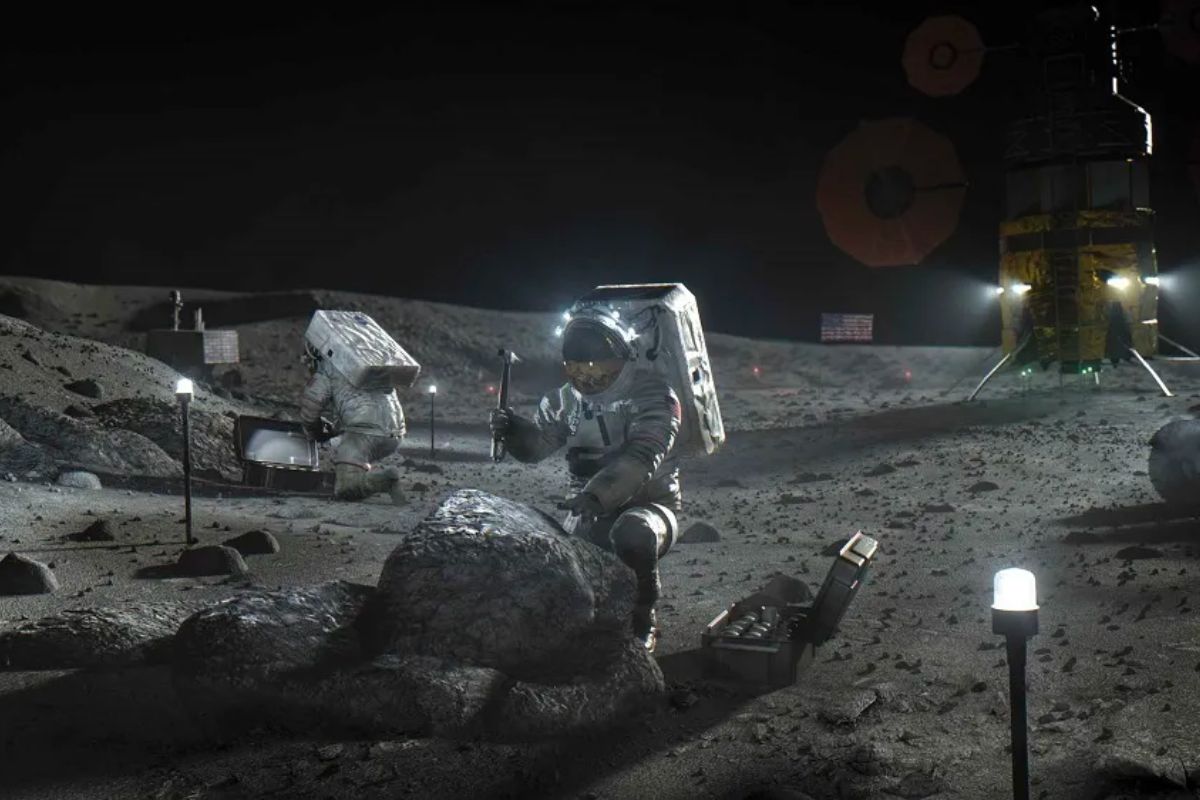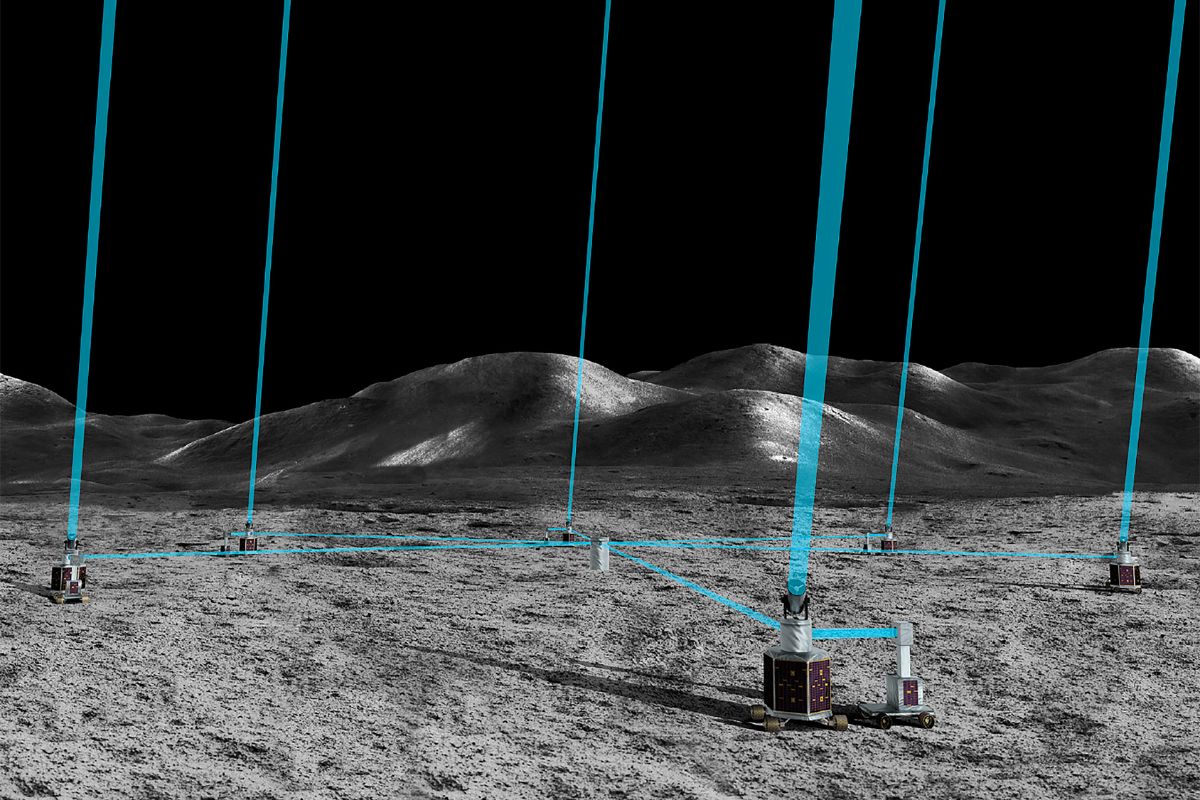Lunar Interferometer: Under the Artemis Program, NASA aims to create a consistent and sustainable presence on the lunar surface. To achieve this, they plan to set up a range of infrastructure, including the Lunar Gateway, a habitat thgat will enable regular trips to and from the moon, and the Artemis Base Camp, which will allow astronauts to stay on the surface for extended periods of up to two months. Additionally, various space agencies are looking to take advantage of the moon’s peaceful environment, which offers ideal conditions for high-resolution telescopes.
Through the NASA Innovative Advance Concepts (NIAC) Program, a team from NASA’s Goddard Space Flight Center has proposed a lunar Long-Baseline Optical Imaging Interferometer (LBI) design, known as the Artemis-enabled Stellar Imager (AeSI), for imaging at visible and ultraviolet wavelengths. Selected for Phase I development, this array of multiple telescopes could potentially operate on the far side of the Moon, capturing detailed images of stellar surfaces and their surroundings.
Kenneth Carpenter and his colleagues at NASA Goddard Space Flight Center (GSFC) presented the proposal. Carpenter, who serves as the Hubble Operations Project Scientist at GSFC adn the ground system scientist for tje Nancy Grace Roman Space Telescope (RST), highlighted the various compelling possibilities for impactful scientific research through NASA’s renewed focus on the Moon. Among these opportunities, they emphasized the potential in establishing observatories that capitalize on the serene “radio quiet” surroundings and prolonged periods of darkness on the far side of the Moon.
The Moon’s orbit causes it to be tidally locked, meaning that one side always faces Earth. As a result, the Moon experiences a 14-day day/night cycle. This means that a “lunar day” lasts for two weeks of constant sunlight, followed by two weeks of continuous darkness during the lunar night.
Additionally, thge Moon’s lack of atmosphere means that optical telescopes can make observations without interference from the atmosphere. This makes the far side of the Moon an ideal environment for conducting high-resolution interferometric imaging, a technique that utilizes multiple telescopes to analyze patterns of interference.
Scientists utilize these patterns to gather information and create a comprehensive image of celestial objects taht are hard to see with regular telescopes. This method was also used by the Event Horizon Telescope (EHT), a network of radio telescopes that spans the globe, to capture the first-ever image of a black hole. The team believes that an interferometry array on the moon has immense scientific potential and could be built in stages to minimize construction costs.
“By utilizing this technology, we can enhance our understanding of celestial bodies, gaining insights into the surfaces of stars, the inner workings of accretion disks surrounding stars and black holes, and even the weather patterns on nearby exoplanets. While a comprehensive facility may be costly and complex, it can be developed gradually, starting with more modest endeavors.”
The technologies can be refined and validated using a pair or trio of compact telescopes with brief baselines. Following the development of the technology, the baselines can be extended, larger telescopes can be incorporated, and the total number of telescopes can be increased. Each of these enhancements can be executed with negligible interruption to the remainder of the system.
Previous research on space-based interferometers focused primarily on free-flying arrays, with a shift in focus attributed to the NASA Vision Missions Studies conducted between 2003 and 2005. These studies compared the benefits and drawbacks of free-flying space concepts and large interferometers on the lunar surface, ultimately deciding that space-based options were preferable due to the lack of established infrastructure on the moon for support and upkeep.

The Artemis Program, led by Carpenter and his team, suggests a shift in the status quo with the forthcoming completion of essential infrastructure such as surface habitats, transportation, drilling, and power facilities. This change presents an opportunity to explore tjhe feasibility of constructing interferometers on the lunar surface.
According to Carpenter and his team, this study will be a significant step towards expanding our capabilities in space, enabling the creation of larger arrays on both the moon and in free space, and allowing us to explore a diverse range of wavelengths and scientific fields. The study will determine the most suitable approach, given current and future technological advancements and human exploration plans, for designing interferometers, either on the lunar surface or in deep space.
They also imagine that a moon-based interferometer would bring about progress in astrophysics, such as the examination of magnetic activity in stars, the cores of active galaxies, and the movements of cosmic phenomena at various levels.
The development andd establishment of such a center of operations will tackle important engineering considerations, including determining the most effective means of integrating optical lines of varying lengths, identifying the most suitable arrangements for the telescopes, and determining the ideal mirror size to achieve both technical and scientific objectives. They also aspire to devise a strategy for the continual maintenance and growth of the facility, utilizing a combination of human and robotic assistance.
The expected advantages of this endeavor extend beyond the development of a UV-optical interferometer and space missions capable of capturing images of black holes, detecting signs of life, and directly observing rocky exoplanets orbiting other stars. Additionally, the establishment of a state-of-the-art facility on the Moon, aligning with the Artemis Program’s goals for human exploration, is expected to generate immense public excitement and engagement.
Ultimately, this endeavor will reignite individuals’ imagination anbd remind them of their capacity to achieve remarkable feats, even when faced with challenging circumstances. Our research will serve as a constant reminder of the immense scale and potential of the cosmos, as well as the incredible accomplishments that can be attained through collaborative effort.
By embracing this ambitious vision, our project will captivate and motivate upcoming generations of STEAM professionals, fostering excitement and inspiration for the fields of Science, Technology, Engineering, Art, and Mathematics. NASA
